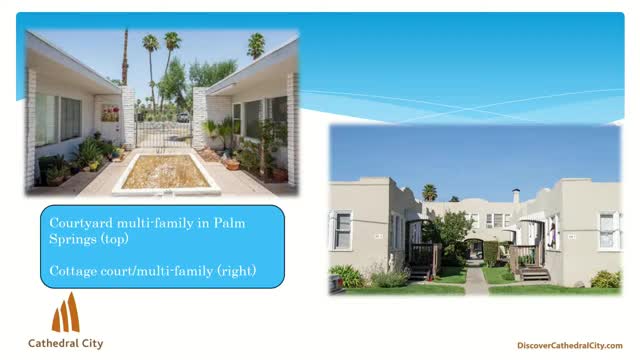City plans bold strategy to boost housing density
July 18, 2024 | Cathedral City, Riverside County, California

This article was created by AI summarizing key points discussed. AI makes mistakes, so for full details and context, please refer to the video of the full meeting. Please report any errors so we can fix them. Report an error »

During a recent government meeting, officials discussed strategies to enhance residential density and development standards in the community, emphasizing the importance of sustainable practices and climate change mitigation.
One highlighted approach is \"gentle density,\" which aims to incrementally increase housing density while maintaining the character of neighborhoods. An example cited was a historic courtyard in Santa Monica, which has successfully integrated modern development with aesthetic appeal. The discussion underscored the need for improved landscaping and shading standards to combat the urban heat island effect, particularly in desert communities where asphalt can significantly raise temperatures.
The meeting also addressed the current residential development code, which restricts many housing types to conditional use permits. Officials are exploring ways to streamline the approval process for smaller projects, potentially allowing staff to approve developments of up to 10 or 12 units without requiring extensive review by planning commissions. This shift aims to facilitate housing development and reduce bureaucratic delays.
Recent projects were showcased, including Newport 17, which features 17 apartment units on 1.5 acres, and Canyon Springs Villas, which includes 58 units on 3.5 acres. Both projects exemplify the push for higher density, with Canyon Springs achieving a density of 16 units per acre.
Overall, the meeting reflected a commitment to fostering development that balances community needs with environmental considerations, aiming to create a more sustainable and livable urban landscape.
One highlighted approach is \"gentle density,\" which aims to incrementally increase housing density while maintaining the character of neighborhoods. An example cited was a historic courtyard in Santa Monica, which has successfully integrated modern development with aesthetic appeal. The discussion underscored the need for improved landscaping and shading standards to combat the urban heat island effect, particularly in desert communities where asphalt can significantly raise temperatures.
The meeting also addressed the current residential development code, which restricts many housing types to conditional use permits. Officials are exploring ways to streamline the approval process for smaller projects, potentially allowing staff to approve developments of up to 10 or 12 units without requiring extensive review by planning commissions. This shift aims to facilitate housing development and reduce bureaucratic delays.
Recent projects were showcased, including Newport 17, which features 17 apartment units on 1.5 acres, and Canyon Springs Villas, which includes 58 units on 3.5 acres. Both projects exemplify the push for higher density, with Canyon Springs achieving a density of 16 units per acre.
Overall, the meeting reflected a commitment to fostering development that balances community needs with environmental considerations, aiming to create a more sustainable and livable urban landscape.
View full meeting
This article is based on a recent meeting—watch the full video and explore the complete transcript for deeper insights into the discussion.
View full meeting
